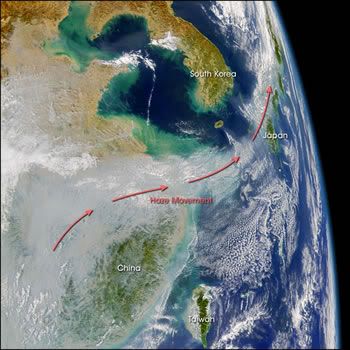http://newscenter.lbl.gov/feature-stories/2010/12/01/lead-isotopes-air-pollution/
About a third of the airborne lead particles recently collected at two sites in the San Francisco Bay Area came from Asia, a finding that underscores the far-flung impacts of air pollution and heralds a new way to learn more about its journey across vast distances.
In a first-of-its-kind study, scientists from the U.S. Department of Energys Lawrence Berkeley National Laboratory and the California Air Resources Board tracked variations in the amount of lead transported across the Pacific over time.
This image from NASA's Sea-viewing Wide Field-of-view Sensor shows dust suspended in the atmosphere above the coast of California on April 15, 2001. The dust was likely carried across the Pacific Ocean from the deserts of Asia. (Image: SeaWiFS Project, NASA/Goddard Space Flight Center, and ORBIMAGE)
They used the lead particles isotopic signature as a chemical return address, which enabled them to trace some of the leads origins to coal and metal ore found only in Asia.
The overall concentration of lead in our samples was small, but a significant portion of it is from Asia, says John Christensen, a staff scientists in Berkeley Labs Earth Sciences Division. He co-authored a study describing this research that was recently published in the journal Environmental Science & Technology.
Its well known that particles and other aerosols cover long distances through the Earths atmosphere. But the details of this transport, such as that of the lead particles 7,000-mile journey from the smokestacks of China to the west coast of North America, are largely unknown. That could change.
This work shows that we can use lead as a tracer for airborne particles within the growing Asian industrial plume, adds Christensen. We can use lead to more thoroughly understand the conditions over the Pacific Ocean that promote the transport of aerosols from Asia to the U.S.
The teams research could help scientists improve computer models that describe how dust-sized aerosols such as air pollution ride the winds across continents and oceans. It could also help air pollution regulators in the U.S. account for pollution that wafts in from thousands of miles away, possibly making it more difficult for some regions to comply with air quality standards.
Transport models are uncertain, says Stephanie Ewing, lead author of the paper and an assistant professor of pedology and soil biogeochemistry at Montana State University. She conducted the research while a postdoctoral researcher in Berkeley Labs Earth Sciences Division.
Adds Ewing, When we can distinguish between sources with an isotopic tool, we have tremendous quantitative power because the measurements are precise and we dont have to rely on a transport model. In fact, we can use the measurements to test and improve the models.
The isotopic composition of lead varies over large regions of the Earths crust. In some cases, a lead isotopic signature can be almost unique to a region. In Asia, for example, mineral dust and other sources of lead such as coal and metal ore have particularly high proportions of 208Pb, the isotope that forms from radioactive decay of thorium.
Leads geographical diversity was elucidated in a study conducted a decade ago by Australian scientists. They catalogued the lead isotopic concentrations at various places around the world, and among many findings, found a distinction between aerosols collected in China versus North America.
This intrigued us, says Christensen. We wanted to look into this further and see if lead isotopes can be used to distinguish between local lead and far-traveled lead.
Scientists from Berkeley Lab and the California Air Resources Board collected samples of fine airborne particles at two sites in the San Francisco Bay Area once a week from December 2007 to May 2008. One site was on Mt. Tamalpais, which rises from the coast north of San Francisco. Another site was further inland at the Chabot Observatory in the East Bay.
Samples were taken to beamline 10.3.1 of Berkeley Labs Advanced Light Source, a national user facility that generates intense x-rays to probe the fundamental properties of substances. The facility enabled the scientists to identify the chemical composition of the samples and measure the concentrations of elements such as silicon, aluminum, iron, potassium, and lead.
They then chemically separated the lead from the other elements and used mass spectrometry to determine its isotopic composition. They found that a median value of 29 percent of the lead particles were of Asian origin.
The scientists also applied this analysis to archived air samples taken from urban sites in central California between 2003 and 2005. Although the prevalence of Asian lead varied from site to site and season to season, it was found throughout central California.
We can use this information to guide the development of particulate transport models, says Christensen. Analysis of lead isotopes provides a powerful indicator for improved understanding of global-scale transport of dust, black carbon, anthropogenic lead and pollutants that drive climate feedback processes.






